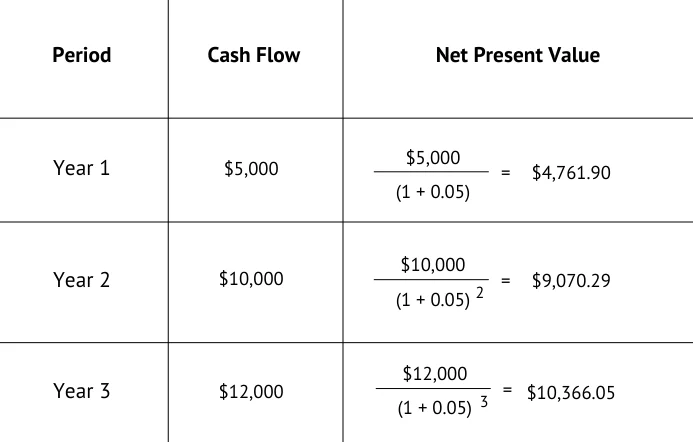Net Present Value: Definition, Formula & Example

What is Net Present Value
Net Present Value (NPV) is the total value of future revenues, subtracted against any cash outflows during the same period. In other words, it calculates future streams of income and brings it in line to its present value. At the same time, it also factors in outflows. For instance, a business may invest $10,000 in some machinery so plays a part in the investment decision.
Net Present Value (NPV) is a useful tool when determining between two or more different investment opportunities. It allows investors to determine the value of future income streams in today’s prices. In turn, it provides a better comparison between investments.
Key Points
- Net Present Value (NPV) is the sum of future cash inflows in present values, subtracted against the initial investment (cash outflows).
- The Net Present Value of an investment is used to compare against multiple projects.
- When the NPV is positive, it is an indication that the project is more attractive than its alternatives.
Net Present Value Formula
Net Present Value looks at multiple years income and calculates each individual year’s present value. For instance, a business may make an investment which is forecast to earn $5k in year 1, $10k in year 2, and $12k in year 3. The Net Present Value calculates how much each year’s income would equate to in current prices. However, it also factors in the cost of the initial investment to get an overall picture of its net return.
So in order the calculate it, you can use the Net Present Value formula:

How to Calculate Net Present Value
In order to calculate Net Present Value, you need the value for the initial investment (I). This does not require any calculation as the initial investment is already in today’s money – so does not need to be discounted. This then goes at the end of the calculation and will be subtracted away from the total cash inflows/revenues.
We then need to find out:
- The number of time periods: as the investment is expected to bring in revenue, it’s important to determine over how many months or years this will occur for.
- The discount rate: the alternative investment opportunity might bring in 5 percent, which could be applied as part of the discount rate.
Once we have the discount rate and the time period, we can enter the future cash flow into the equation. If we take an example and say that over a three-year period, a business makes $5,000 in its first year, $10,000 in the second, and $12,000 in the third. This can be seen below using a discount rate of 5 percent at yearly intervals.

This brings up the present value for each individual year. So based on a discount rate of 5 percent, the business makes a total of $24,198.24 across three years. However, to calculate net present value, we must also take away the initial investment. In this example, we can assume the initial investment cost $10,000. So once this has been taken away from the total, we receive the net present value of $14,198.24.
Net Present Value Explained
Due to the nature of money, it tends to lose its value over time. Inflation is a key factor in this as a dollar today is not worth the same in a year’s time. In addition to inflation, there is the opportunity cost to factor in. For instance, a $5,000 investment might make a 5 percent return in a savings account. So the discount rate that is applied allows for this opportunity cost.
If we take an example of an investor who has two options. Option A allows the investor to receive $500 today. Option B allows the investor to receive $500 next year. Now any rational person under normal economic conditions would choose Option A – the $500 today. However, the decision becomes more complicated if the alternative option was $525 for example.
This alternative option offers the investor a return on investment of 5 percent. Yet they might not find that acceptable. So in this case, when analysing other investments, this 5 percent could be used as the discount rate to determine its present value. In turn, this will help investors choose the best investment for themselves and their risk appetite.
A firm often finds itself with multiple investment options. It might be able to invest in safe government bonds at a rate of 3 percent – so may allocate this is the discount rate when comparing investment opportunities. For example, one investment may earn 10 percent per year, but costs 5 percent to finance. This may mean that the additional level of risk might not be worth it over safer government bonds.
If we take an example, a company may invest in a new factory that will cost $5 million. At the same time, it is expected to bring in $2 million per year across five years. The company has a choice to make between such an investment, or the alternative. In this case, the company might choose between the $5 million factory, or investing the same amount into the stock market for an annual return of 5 percent. Net present value will help the company determine which option would provide the best return.
What Net Present Value Can Tell You
The Net Present Value (NPV) of an investment opportunity accounts for the time value of money. By doing so, it allows investors to compare multiple investments. Anything with a negative NPV is generally seen as a bad investment. This is because other investments provide a greater return. However, it may still be useful if other investments provide a far greater risk.
NPV identifies the profitability of an investment using what that dollar would be worth in the future. In other words, it calculates tomorrow’s dollar and translates that into today’s value. This is useful because money loses value due to inflation, which means that dollars have less value over time.
One of the important things when determining an investment is whether it will actually bring in a ‘real’ return. In other words, will it produce a return on investment that is greater than inflation.
The NPV of an investment looks to see if the future cash flow will be greater than the initial investment cost. This is because the investment cost is in today’s money. However, future cash flow might be in a year or five years’ time. So NPV allows investors to compare the future value of those cash flows and see how it compares.
For example, most investors would want to invest $1,000 today rather than wait until next year and receive the same $1,000. This is because inflation tends to erode value, so investors will always want to be chasing a return. In turn, an opportunity to make $1,050 next year could provide tempting for the investor. This equates to a 5% rate of return (RoR). However, there may be other investments which provide greater returns. So in order to compare, the initial 5 percent could be used as the discount rate to calculate it’s NPV.
Positive vs. Negative NPV
When the Net Present Value (NPV) is positive, this shows that the investment will bring about a profit in present dollars. This is because the cash inflows will exceed the investment costs. At the same time, it accounts for a comparative investment through the discount rate. So a positive value can also suggest that it’s a more lucrative investment than alternatives.
On the other hand, an investment with a negative NPV would produce a loss. This is because the cash inflows exceed the initial investment. Yet this can be heavily influenced by the discount rate.
For instance, a high discount rate is more likely to lead to a negative NPV. This is because the returns have to be higher due to the higher rate of returns. If an investor could earn 8 percent from a savings account – it would mean that any other investment would need to exceed those earnings to be worthwhile.
Net Present Value Example
An investor has two options. They can either put their $10,000 into a savings account which earns them 4 percent interest per year. Alternatively, they can invest it in a local enterprise which is forecast to bring in $2,500 in year 1, $4,500 in year 2, and $5,000 in year 3.
In the case of the first option, the investor is able to calculate the future value in three years’ time. When the initial $10,000 is compounded annually, the investor would have $11,248.62 – earning $1,248.62.
Now, in order to calculate which investment opportunity is better, we can calculate the net present value of the second option. We can do that using the formula we mentioned earlier.

In this example, the present value of year 1 would equal 2,500 / 1+0.04 = $2,403.85
In year 2 it would equal 4,500 / (1 + 0.04)^2 = $4,160.50
And in year 3 it would equal 5,000 / (1 + 0.04)^3 = $4,444.98
So in total, this would equal $11,009.33. We then take away the initial investment, which leaves us with $1,009.33 as the Net Present Value.
When looking at the future value of the first option – $11,248.62, or a net profit of $1,248.62, it may seem like option one is the preferred option. However, this is missing the discount rate which needs to be applied to find out the present value. Only then can we compare like for like, or apples with apples.
When compounded annually, we would expect the investment to equal $10,400 in year 1, $10,816 in year 2, and $11,248.64 in year 3. We can then apply the present value formula.
So in year 3, the present value would equal 11,248.64 / (1+0.04)^3 = $10,000. This is because the discount rate is exactly the same as that by which the investment makes a return.
So now we have compared apples for apples – we can see that option 2 is the best investment as it produces $1,009.33 in additional profit over and above that of option 1.
Net Present Value vs Present Value
Some of the confusion surrounding net present value (NPV) comes from its comparison against present value. How does it differ? Well net present value is the difference between cash inflows and cash outflows over a set period. In other words, it calculates what that future cash inflow would be worth in today’s dollars.
By comparison, present value looks at a static value at some point in the future and brings it in line with today’s value.
Instead, net present value looks at multiple cash inflows in the future and brings them in line with today’s value. This helps companies and investors determine whether one project or investment is likely to be more successful than another. In addition, the NPV also considers the initial capital investment – which creates the net value. Therefore, it makes it a better indicator of investment profitability.
FAQs on Net Present Value
Net Present Value (NPV) is the total value of future revenues, subtracted against any cash outflows during the same period.
A NPV above zero would suggest that an investment is worthwhile. This is because the NPV calculation accounts for variables such as the cost of capital, opportunity cost, and the discount rate of comparable investments. The discount rate will compare it against other investments and therefore if the outcome is positive, then the investment outperfoms the alternative option.
NPV uses the discount rate in order to allow for the time value of money (TVM). This is the concept that a dollar today will be worth less in a years time due to factors such as inflation. Therefore cash loses value over time. This is then used as a discount rate to allocate for such, but will depend on the other investment options available and their expected returns.
About Paul
Paul Boyce is an economics editor with over 10 years experience in the industry. Currently working as a consultant within the financial services sector, Paul is the CEO and chief editor of BoyceWire. He has written publications for FEE, the Mises Institute, and many others.

Further Reading
 Earnest Money - Table of Contents What is Earnest Money? Purpose of Earnest Money How Much Earnest Money is Required? Is Earnest Money…
Earnest Money - Table of Contents What is Earnest Money? Purpose of Earnest Money How Much Earnest Money is Required? Is Earnest Money…  Cognitive Dissonance - Cognitive dissonance is the psychological discomfort experienced when a person holds conflicting beliefs or attitudes.
Cognitive Dissonance - Cognitive dissonance is the psychological discomfort experienced when a person holds conflicting beliefs or attitudes.  Fascism vs Communism - Fascism emphasizes national unity and the supremacy of one race or ethnicity, while communism promotes equality and the abolition of…
Fascism vs Communism - Fascism emphasizes national unity and the supremacy of one race or ethnicity, while communism promotes equality and the abolition of… 